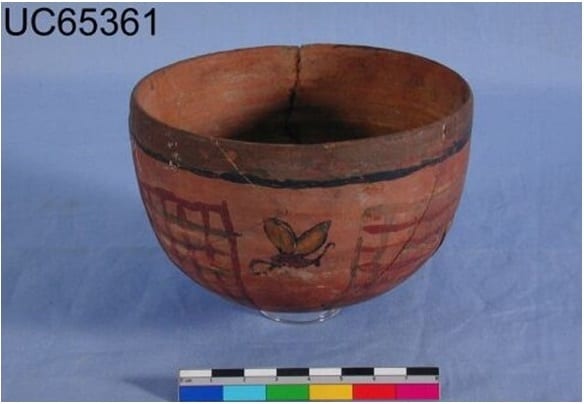A Honey Pot for Springtime!
By Susi Pancaldo, on 31 March 2016
As a Conservator, I often think of how privileged I am to be able to handle and examine museum objects, up close and personal. Not all objects move me, but at the moment I am very pleased to be working on this one:

UC65361, Ceramic bowl from the Petrie Museum of Egyptian Archaeology, UCL. Height 7cm, diameter 10.5cm.
This ceramic bowl was probably made in Upper (southern) Egypt in the late Ptolemaic or Roman Period; that is, in the centuries just before or after the beginning of the Common Era (0 BC). The delicate vessel was made on a slow potter’s wheel from a fine-grained, pink clay. After drying, it was was painted with a thin red clay layer (‘slip’). Lastly, a scene of busy bees, in flight amongst honey combs, was painted using a host of colours: shades of black, red, yellow and white.
Who made the bowl, who used it and what it was used for in ancient times, we do not know for sure. We do know that the vessel was archaeologically deposited at some point, and then excavated, probably around the turn of the 20th century AD. The bowl made its way to the UK and into the Petrie Museum, probably from one of Sir Wm M F Petrie’s excavations – at Koptos, for example, or Qasr Ibrim in Nubia, both sites where this type of pottery has been found. Alternatively, the vessel may have come to the museum in the late 1960s, via the Henry Wellcome Trust. Research in the museum’s archives would likely reveal which.
Whatever the source, it is clear that the vessel has been broken and repaired at least twice since it was excavated. This was revealed when the bowl was examined under ultra-violet light:
In visible light, adhesive along the break edges (and in some areas smeared on the surface) appears grimy and yellowed from age. It was only when I looked at the fragment joins under UV radiation that two different resins were detected.
Examination under UV radiation (wearing safety goggles to protect the eyes!) is a handy trick which takes advantage of the fact that some materials, when exposed UV, will fluoresce – that is, they emit light radiation which can be detected by the human eye. If a distinct colour is emitted – such as bright orange, or the eerie light green seen in the images above right – an educated guess can be made about the identity of the substance. From experience, I can be fairly confident that the orange-fluorescent substance seen in the right-hand images above is shellac, and the green-fluorescent substance is cellulose nitrate. Both these materials were commonly used in the past to repair archaeological ceramics.
Now that I have an idea of the identity of the resins used on the vessel, I can carry out further tests for confirmation. It is important to confirm as precisely as possible what conservation materials were used — in part to inform treatment decisions, but also because identification of the adhesives will contribute to an understanding of the post-excavation history of the object and the field of archaeological conservation. Further tests will include examining the solubility of the resins using various organic solvents, and conducting Fourier transform infrared spectroscopy (FTIR) analysis.
Then, finally, the vessel can be repaired, for a third time! I will first remove as much of the old, aged resins as possible from surfaces of the pottery fragments. I will then readhere the fragments using a modern conservation adhesive. The bowl will then be ready for redisplay – what a way to celebrate Spring!!
Susi Pancaldo is Senior Conservator, UCL PACE Museums and Collections
One Response to “A Honey Pot for Springtime!”
- 1
 Close
Close



djdjohnson@blueyonder.co.uk
Dear Susi,
I saw your blog while trying to find the name of the curator of the UCL archaeological collections. I just tried to contact Ian Carrol, the collections manager for UCL, having seemingly lost the name of the Curator of the archaeological collection who I knew a couple of years ago. Perhaps she has retired? Ian seems to be on holiday for the next month.
I am a student of Cypriot archaeology and also a collector, having always intended to give my collection back to Cyprus. This is close to happening (the lawyer is currently finishing writing the agreement with the museum). I expect the transfer of ownership to be signed in about a month, though only part of the collection will be physically transferred at once, the rest following over the next few years.
The curator I previously met and corresponded with had suggested that it might be ethical, under the circumstances, for your conservation department to advise me about the conservation possibilities for an important piece of Middle Cypriot White Painted Ware which was very crudely mended and touched up, but then, unfortunately, varnished by an Austrian General and collector who bought it in the mid 60s while stationed in Cyprus with the UN protection forces.
Who should I contact about this now? Obviously no actual work on the piece will be done without the agreement of the new owners.
You can see the collection on http://ant.david-johnson.co.uk . Click on “thumbnails” for an overview, and on any object for a detailed entry (the photo can be further enlarged). The piece in question is the bowl with two headed bulls on the rim.
Best wishes
David